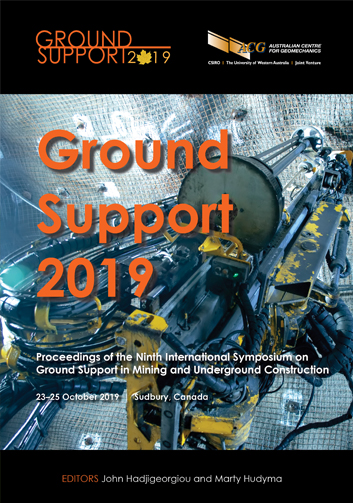Early strength development of shotcrete for rapid mine development and behaviour under dynamic loads

|
Authors: Erismann, F; Hansson, M |
DOI https://doi.org/10.36487/ACG_rep/1925_40_Erismann
Cite As:
Erismann, F & Hansson, M 2019, 'Early strength development of shotcrete for rapid mine development and behaviour under dynamic loads', in J Hadjigeorgiou & M Hudyma (eds), Ground Support 2019: Proceedings of the Ninth International Symposium on Ground Support in Mining and Underground Construction, Australian Centre for Geomechanics, Perth, pp. 559-570, https://doi.org/10.36487/ACG_rep/1925_40_Erismann
Abstract:
Ever deeper mine developments combined with wider spans and layouts with close infrastructure alignments represent an increasing challenge for installed underground support. Destressing and sudden seismic events frequently create severe damage to the vital underground support within the haulage, ore handling and extraction infrastructure. In-cycle shotcrete has proven to be the primary support of choice in most large-scale mine developments, including the recent super-cave developments, such as Oyu Tolgoi, Chuquicamata, El Teniente and Grasberg. As a result, increased efforts have been undertaken over the past years to understand the behaviour of fibre-reinforced sprayed concrete under sudden dynamic loads, with evaluations of the latest developments in fibre technologies and shotcrete mix designs. Together with Luossavaara-Kiirunavaara Aktiebolag (LKAB) and the operating team at the Kiirunavaara and Malmberget operations in Sweden, among the world’s most stringent operations when it comes to early strength requirements and energy absorption of the shotcrete liner, Sika undertook extensive testing of different shotcrete mix designs. Simulated seismic shocks were used in order to evaluate primary shotcrete liners by observing their behaviour under such rapid deformation events (Swedberg 2013; Swedberg et al. 2014). The major findings and test results form part of this paper. Particular focus was also given to the early strength development of the sprayed shotcrete because destressing events usually occur soon after a face has been blasted (Amberg 2006), and thus rapid strength development is of particular interest. For reliable in situ onsite strength development measurement, Sika developed an ultrasonic-based tool to measure the strength of the sprayed concrete at the sprayed location and will allow development teams to re-enter secured perimeters at the right time. This is seen to have a major positive impact on safety and productivity of any rapid mine development project.
Keywords: shotcrete, concrete, fibre,accelerator, early strength, cycle time, blast cycle, efficiency, ultrasound, MiniShot, Sika, LKAB, block cave, sprayed concrete, yielding, energy absorption, seismic, destressing, mining, underground, rapid development
References:
Amberg, F 2006, Tunnelling in High Overburden: The Swiss Approach, ITA/AITES Training Course, Tunnel Engineering, Seoul.
ASTM International 2012, Standard Test Method for Flexural Toughness of Fibre Reinforced Concrete (Using Centrally Loaded Round Panel) (ASTM C1550-12a), ASTM International, West Conshohocken.
Bernard, ES 2004 (ed.), ‘Durability of cracked fibre reinforced shotcrete’, Shotcrete: More Engineering Developments—Proceedings for the Second International Conference on Engineering Developments in Shotcrete, October 2004, Cairns.
Bernard, ES 2009, ‘Early-age re-entry under fresh fibre reinforced shotcrete’, Proceedings of Shotcrete for Underground Support XI, Engineering Conferences International, Switzerland.
Hadjigeorgiou, J & Potvin, Y 2011, ‘A critical assessment of dynamic rock reinforcement and support testing facilities’, Rock Mechanics and Rock Engineering, vol. 44, pp. 565–578.
Lindlar, B, Oblak, L, Lootens, D & Stenger, C 2014, ‘From tunnel to laboratory: Scaling of shotcrete testing’, paper presented at the 7th International Symposium on Sprayed Concrete, Sandefjord, 16–19 June.
Lootens, D, Hansson, M, Oblak, L, Lindlar, B 2014, ‘Ultrasonic wave propagation for strength measurements: Application in Shotcrete’, paper presented at the 7th International Symposium on Sprayed Concrete, Sandefjord, 16–19 June.
Oblak, L, Lindlar, B, Lootens, D 2012, ‘Continuous monitoring of strength evolution of shotcrete’, paper presented at the 10th International Shotcrete Conference, Alpbach, 12–13 January.
Swedberg, E 2013, Tidig Hållfasthet för Sprutbetong och Cementingjuten Bergbult, PhD thesis, Luleå University of Technology, Luleå.
Swedburg, E, Thyni, F, Töyrä, J & Eitzenberger, A 2014, ‘Rock support testing in Luossavaara-Kiirunavaara AB's underground mines, Sweden’, in M Hudyma & Y Potvin (eds), Proceedings of the Seventh International Conference on Deep and High Stress Mining, Australian Centre for Geomechanics, Perth, pp. 139–150.
Swedberg, E & Krutrök, B 2016, ‘Drop testing of concrete panels and welded wire mesh at LKABs Kiirunavaara mine’, in E Nordlund, TH Jones & A Eitzenberger (eds), Proceedings of the Eighth International Symposium on Ground Support in Mining and Underground Construction, Luleå University of Technology, Luleå.
Thyni, F 2014, Design of Shotcrete for Dynamic Rock Support by Static Testing, PhD thesis, Luleå University of Technology, Luleå.
© Copyright 2025, Australian Centre for Geomechanics (ACG), The University of Western Australia. All rights reserved.
View copyright/legal information
Please direct any queries or error reports to repository-acg@uwa.edu.au
View copyright/legal information
Please direct any queries or error reports to repository-acg@uwa.edu.au